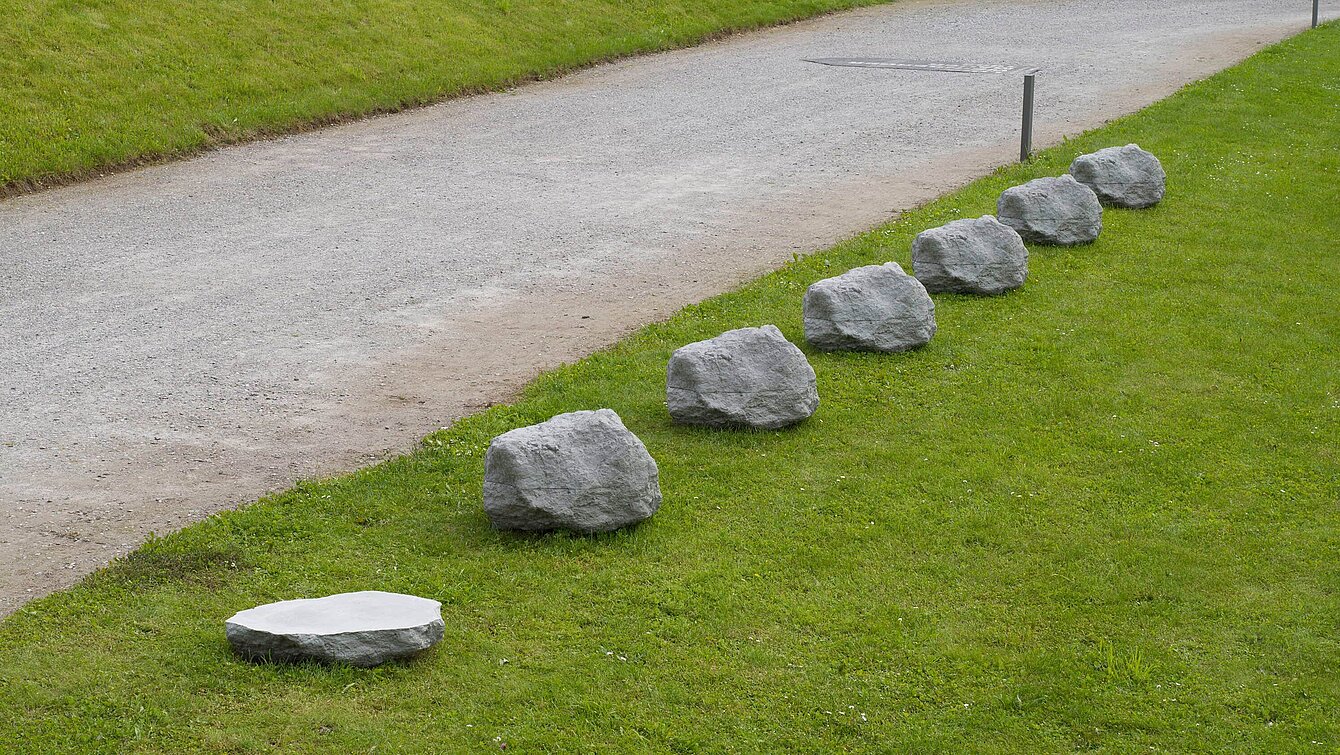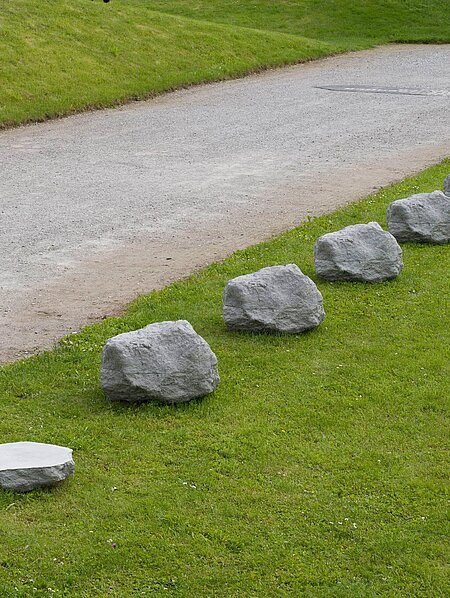In seiner kontinuierlichen Auseinandersetzung mit dem Thema Ressourcen und Beton befasst sich Weber auch mit dem „Neuen Materialismus“, womit auch die Frage nach global unendlich erscheinender Materialverfügbarkeit aufgeworfen wird. Als Ausgangsmaterial für sechs komma vier wählt Christoph Weber einen etwa 200 kg schweren, frisch gebrochenen Kalkstein aus dem Steinbruch des LaFarge-Zementwerks Mannersdorf am Fuße des Leithagebirges. Er eruiert die Menge an Zement, die der gewählte Kalkstein abgeworfen hätte, und berechnet, dass in 6,4 Kopien des Originalsteins aus Beton dieselbe Menge an Zement zu finden ist. Daraus ergibt sich in absurder Formalität die Logik seiner Skulptur: 6,4-mal wird ein maschinell gesprengter und zufällig gebrochener, jedoch natürlich erscheinender Stein klassisch gegossen, und, resultierend aus der Berechnung, multipel wieder zusammengesetzt, wobei die Nahtstellen des Gussvorgangs unkaschiert erkennbar sind ‒ „ich arbeite mit, über und gegen Beton“.
sechs komma vier, 2021
Christoph Weber


Bildinformationen
Autor*in
Elisabeth Fiedler, Kurztext adaptiert von Peter Gspandl-Pataki
Planübersicht
Besitzer*in
Universalmuseum Joanneum
Künstler*innenbiografie
Alle anzeigen
Zum Werk
Beton definiert sich als jener Werkstoff, der unsere wirtschaftliche, ökologische und gesellschaftspolitische Entwicklung seit dem Altertum begleitet. Vom antiken Wasserleitungsbau, den Aquädukten, der Errichtung des Kolosseums oder des Pantheons bis zu den unsprengbaren Bunkern der Nationalsozialisten, von der modernistischen Architektur Le Corbusiers über den Brutalismus bis zur gigantomanischen Errichtung höchster Bauwerke und ganzer Inseln in der Jetztzeit begleitet uns Beton auch als Metapher für Entwicklungs- und Zerstörungspotenzial sowie für menschliche Selbstüberschätzung. Ein wesentlicher Bestandteil dabei ist Sand als weltweit am meisten genutzter und zu Ende gehender Rohstoff. Im Jahr 2020 hat die anthropogene Masse jene der Biomasse eingeholt, das heißt, es existiert mehr vom Menschen Produziertes ‒ das Meiste davon aus Beton ‒, als Flora, Fauna und alles von der Natur Vorgegebene.
Dies reflektierend und an Entstehung, Bedeutung, Veränderlichkeit und Beeinflussbarkeit dieses zwischen Rohheit, Sprödigkeit und Fragilität widersprüchlich und für die Kunstproduktion banal erscheinenden Werkstoffs interessiert, seziert Weber Beton, um in neuen Materialisierungsprozessen ‒ „ich arbeite mit, über und gegen Beton“ ‒ differenzierte formale Möglichkeitsentwürfe in bildhauerischem Selbstverständnis und in poetischer Gelassenheit zu generieren. Gleichzeitig fokussiert er mit der ausgeschriebenen Titelgebung, bezugnehmend auf menschlichen Eingriff, das Mittel sprachlicher Repräsentation.
Als Ausgangsmaterial für seine Arbeit sechs komma vier wählt er einen etwa 200 kg schweren, frisch gebrochenen Kalkstein aus dem Steinbruch des LaFarge-Zementwerks Mannersdorf am Fuße des Leithagebirges. Dort, inmitten des ehemaligen Paratethysmeeres gelegen, haben vor 16 bis 14 Millionen Jahren jene Kalkrotalgen gelebt, die den heutigen Kalkstein bilden.
Kalkstein wird im industriellen Prozess normalerweise nach der Sprengung von der Betonindustrie weiter zerkleinert, zu Klinkern gebacken und zu Zement vermahlen. Zement ist jenes hydraulische Bindemittel für Sand und Schotter, das Beton erhärten lässt. Dieser Erhärtungsvorgang vollzieht sich paradoxerweise nur durch Zugabe von Wasser und macht Beton dadurch zu einer liquiden Substanz. Diese scheinbare Widersprüchlichkeit entpuppt sich als Tautologie, innerhalb derer die Flüssigkeit des Materials ebenso wahr ist wie dessen Stabilität. An dieser Material- und Bedeutungskippmöglichkeit setzt Christoph Weber an.
Er eruiert die Menge an Zement, die der gewählte Kalkstein abgeworfen hätte, und berechnet, dass in 6,4 Kopien des Originalsteins aus Beton dieselbe Menge an Zement zu finden ist. Daraus ergibt sich in absurder Formalität die Logik seiner Skulptur: 6,4-mal wird ein maschinell gesprengter und zufällig gebrochener, jedoch natürlich erscheinender Stein klassisch gegossen, und, resultierend aus der Berechnung, multipel wieder zusammengesetzt, wobei die Nahtstellen des Gussvorgangs unkaschiert erkennbar sind. Dadurch und in der von Weber erstmals eingesetzten Prozentklausel wird die „Gemachtheit“ des Produkthaften betont. Er irritiert in seinem Spiel zwischen scheinbarer Natürlichkeit des Steins und menschlicher Beeinflussung, Imitationsfähigkeit und Produktion, denn der Stein ist Skulptur, die tatsächlich anthropogen geformt wurde. Absurd erscheint auch die Multiplizität einer Ausgangsform, die selbst nur „Bruch“-teil bzw. zufälliger Ausschnitt eines Gesamten ist.
Beton verändert hier nicht nur seinen Aggregatzustand. Er simuliert die Authentizität seines Ursprungsmaterials, des Kalksteins, in seinem Aussehen, täuscht die Echtheit einer von der Natur geformten Felsstruktur vor, die tatsächlich von menschlich konstruierten Maschinen produziert wurde. Seine Bruchstellen resultieren aus dem Zufallsprinzip der Detonationsstärke. Die Befragung des Ursprungs, der Bearbeitung und Bedeutungsumwertung von Ausgangsmaterial und künstlerischer Setzung sind inhärente Bestandteile von Christoph Webers Denken und Arbeiten. Im Oszillieren zwischen den Polen von roh und gekocht im Sinne von Claude Lévi-Strauss, dem von der Natur Vorgegebenen und der Konstruktionsfähigkeit des Menschen, der vermeintlichen Ursprungsform und seiner Transformationsfähigkeit aufgrund exakt errechneter Dechiffrierungsvorgänge entwickelt Weber einen neuen Skulpturenbegriff, der die vermeintliche Einlösbarkeit von formalen und inhaltlichen Versprechungen reflektiert.
In seiner kontinuierlichen Auseinandersetzung mit dem Thema Ressourcen und Beton befasst sich Weber auch mit dem „Neuen Materialismus“ ‒ explizit nennt er Rosi Braidotti, die die Diversion von Natur und Kultur von Lévi-Strauss überwindet, sich mit den Beziehungen des Menschen zu Technologie, Natur und Umwelt auseinandersetzt und von Natur-Kultur-Verhältnissen als Kontinuen ausgeht. Auch der Anthropozän-Diskurs von Bruno Latour, der die Absurdität der Idee unendlichen Wirtschaftswachstums auf einem biophysikalischen Planeten evident werden lässt und ein Ende des Dualismus von Natur und Kultur fordert, ist wesentlich für die Arbeit von Christoph Weber, dessen Denken zwischen diesen Modellen oszilliert.
Auch wird in der Arbeit sechs komma vier Webers Bezug zur Fotografie, zur Frage nach Wirklichkeitsausschnitt, Authentizität, Reproduktionsfähigkeit, Multiplizität und Serialität deutlich. Ebenso klar wird in der 6,4-fachen Auflage, die sich aus der dem Beton innewohnenden Materialzusammensetzung ergibt, dass es um exakte Berechnung und nicht um willkürliche Weiterproduktion geht, womit auch die Frage nach global grundsätzlich unendlich erscheinender Materialverfügbarkeit aufgeworfen wird.
Mit dieser tautologischen Schleife thematisiert Christoph Weber also Fragen nach Vervielfältigung und Ressourcenverknappung und stellt in seinem spezifischen skulpturalen Ansatz anthropozentrischen Einfluss und biogeologisch Vorhandenes in lakonischer Sentimentalität gegenüber: Die natürlich wirkende Form des Steines war tatsächlich schon der erste Schritt eines industriellen Prozesses durch Sprengung, die Materialität des scheinbaren Abbildes entspricht nicht dem Original, auch die lapidare und doch in exakt gleichen Abständen gewählte Setzung im Skulpturenpark am Wegrand nimmt Anleihe an der inflationären Ablage von Steinen ähnlicher Größe zur Abgrenzung von Grundstücken oder um das Parken von Autos in der Wiese einzudämmen. Damit stellt sich nicht nur die Frage nach Wahrheit oder Fake, sondern auch jene nach dem In-Beziehung-Setzen von Potenzial, Umwandlung, Ausdruck und Auswirkung in berechneter und begrenzt wiederholbarer Form.
Neben der Tatsache, dass der Österreichische Skulpturenpark unmittelbar an Schotterteiche und ein Betonwerk grenzt, referenziert Weber zwei weitere Aspekte des Parks: Zum einen liegt dieser partiell auf einer ehemaligen Mülldeponie, was menschliches Eingreifen ebenso bedeutet wie die Errichtung einer pyramidalen Landschaftsarchitektur. Zum anderen platziert der Künstler seine Arbeit in der Nähe der aus nummerierten Steinen zusammengebauten Arbeit von Lois Weinberger, der sich stets mit dem Naturbegriff und dem menschlichen Eingriff kritisch auseinandersetzte.


















